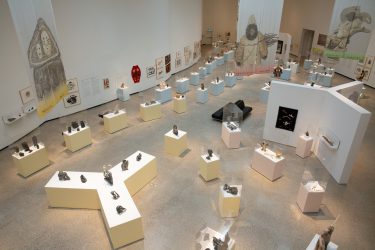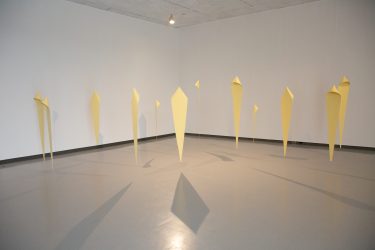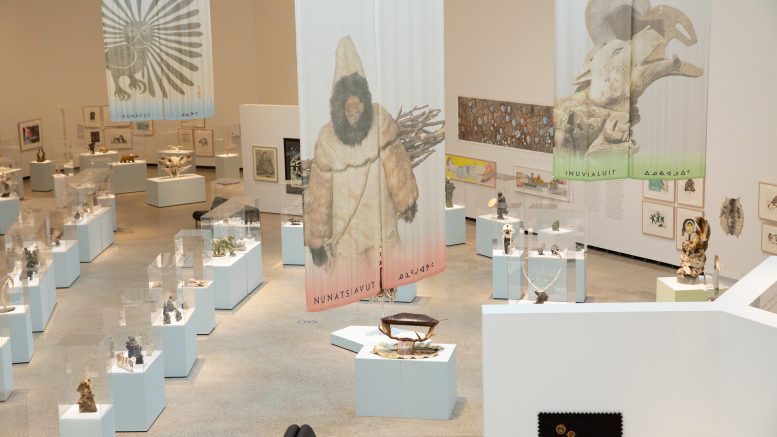Following a personal tradition from the previous year, I made my way to the Winnipeg Art Gallery (WAG-Qaumajuq) to experience an afternoon of Indigenous artwork and programming for National Indigenous Peoples Day last Wednesday.
On June 9, WAG-Qaumajuq released new self-guided tours for those walking around the gallery, as well as a new way to tour virtually. The first tour using this new platform launched on National Indigenous Peoples Day. Available worldwide, the virtual tour features Indigenous languages from Manitoba, along with dialects from Inuit Nunangat — the Inuit homeland in Canada.
With this in mind, I was eager to participate in this year’s events. I was only able to attend the afternoon tours, but for individuals who prefer quieter forms of celebration, walking the galleries during the day is just as much fun as the evening events.
My first destination was the tour of Inuit Sanaugangit: Art Across Time, an exhibit that features nearly 400 works from across the Arctic, with some pieces dating as far back as 200 BCE. This gallery was magnificent to behold. When you enter, you are thrown into a world of historic and contemporary art forms like sculpture, drawings, clothing, printmaking and film.
My favourite thing about this exhibit was how you could see each region’s different artistic styles and aesthetics. A piece in the Alaska region I found myself drawn to was “Small Floral Secrets” (2009) by Sonya Kelliher-Combs, from the town of Utqiagvik, Alaska. The piece is made up of several small pouch-like creations placed directly on the wall in rows of seven, made of found bedsheets, acrylic paint, glass beads, human hair, nylon thread and steel pins. Each “small floral secret” is unique. The meaning of this piece is up for interpretation, but something about it pulled me in, and I spent several minutes examining each row, smiling wider every time I looked at them.
It was during this moment of being absorbed in “Small Floral Secrets” that I realized I had lost my tour group. Resting for a moment on a small couch placed in the centre of a now-empty Inuit Sanaugangit, I took a moment to reflect on my feelings and scout out my now-solo journey to the next gallery, The Art of Faye HeavyShield.
Faye HeavyShield is a Blackfoot (Blood) woman from the Kainai territory. Curated by Felicia Gay and informed by the relationship between Gay and HeavyShield, this exhibition is described by the WAG-Qaumajuq as “built on the bones of memory and story.”
This was my favourite exhibit. There wasn’t a single piece I saw that didn’t move me, but there was one piece in particular that I absolutely loved.
“Aapaskaiyaawa (they are dancing)” (2002) is made with acrylic on canvas, along with beads and plastic filament. The piece reflects on time, kin, dancing as a form of celebration and the significance of honouring ancestors from an Indigenous worldview.
The last line of the work’s description panel reads, “one day we will pass through and enter the dance, watching our kin in time,” and it was this line that brought me to tears. 
The installation contains several triangle-like shapes hanging from the ceiling. I realized while observing that each individual shape was meant to represent an ancestor. The individuals were made so that, with even the slightest breeze, they sway and move around, “dancing.”
To end my final gallery tour, I carefully walked the little path between the individual figures hanging from the ceiling. I couldn’t help but think about my own ancestors and my own family. As I finished my walk and turned around, the figures started to dance, their shadows dancing with them.
After exiting the exhibit, there were several tables set up for folks to do a mixed-media collage workshop inspired by HeavyShield’s work. The idea was to create a piece while thinking about your own community, family, friends and connection to land and environment. The collage I made was silly looking, but I’m proud of it.
As I was wrapping up, collage in hand, I noticed the doors to Anaanatta Unikkaangit: Our Mother’s Stories. It showcases the work of the five Inuit artists on the Kenojuak Ashevak Memorial Award 2023 shortlist: Billy Gauthier, Gayle Uyagaqi Kabloona, Kablusiak, Maureen Gruben and Ningiukulu Teevee.
Some of my favourite pieces in this exhibition were “Tiiturumaviit? (would you like a tea?)” (2023) and “Ningiuq (grandmother)” (2019) by Gayle Uyagaqi Kabloona.
“Tiiturumaviit?” is a digitally manipulated linocut print of six cups in three rows, all different colours and each the exact same design, with a tea bag string hanging out of them. “Ningiuq” is a digitally enlarged woodcut print with a collage of a grandmother sitting down and sewing on a background of several rows of sewing needles.
I thought these pieces were so sweet, I couldn’t help but linger and take them in. Everyone should take an opportunity to go to WAG-Qaumajuq and check out these exhibits. Admission is free for Indigenous visitors year round.
The WAG-Qaumajuq will feature Inuit Sanaugangit until Jan. 7, 2024, The Art of Faye HeavyShield is up until Aug. 27, 2023, and Anaanatta Unikkaangit is on until Nov. 12, 2023.


